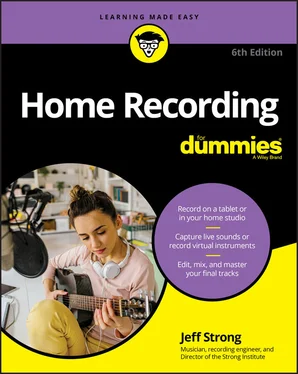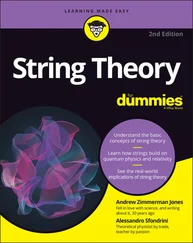Voice: One track and lavalier mic for each person talking, or one shotgun mic and one audio track for all voices.
Ambient: An optional stereo mic or a matched pair of mics and two audio tracks for ambient sounds.
Aside from these tracks, you probably want extra tracks available to record background music or sound effects. Of course, you also need the software that will allow you to mix multiple tracks.
Mobile on-location studio
Mobile on-location recording can be as simple as a stereo mic plugged into a two-track field recorder or as complex as the live recording setup I describe earlier in this section.
 When I record live on location, I like use a four-track Zoom recorder and two sets of mics, either stereo or matched pairs. This allows me to capture the same performance twice and gives me a backup in case something goes wrong with one set of tracks. It also gives me the opportunity to place each set of mics in a slightly different location to give me options when I mix the performance.
When I record live on location, I like use a four-track Zoom recorder and two sets of mics, either stereo or matched pairs. This allows me to capture the same performance twice and gives me a backup in case something goes wrong with one set of tracks. It also gives me the opportunity to place each set of mics in a slightly different location to give me options when I mix the performance.
Chapter 3
Getting Connected: Setting Up Your Studio
IN THIS CHAPTER
 Getting to know the various types of connectors
Getting to know the various types of connectors
 Plugging in your equipment
Plugging in your equipment
 Creating an efficient workstation
Creating an efficient workstation
 Making your room sound great (or at least decent)
Making your room sound great (or at least decent)
Okay, so you’re ready to turn that spare bedroom or basement into a recording studio. You need to unpack all your shiny new gear and get it plugged in properly, and your room needs to work for you. This involves creating an efficient place to work, but above all, it means following tips in this chapter to make your room sound good. This can be tricky — after all, pro studios spend tons of time and money so that their studios sound great. You may not need to spend a ton of money (as if you could), but you do need to spend some time.
After you decide on a space for your home recording system, the next steps involve setting up the system and preparing your space to work for you. In this chapter, I help you make sense of all those analog or digital connectors and help you plug them all in properly.
This chapter also shows you how to find the best way for you to work in your environment, with a fair measure of tips and tricks thrown in to make your room sound as good as possible.
Understanding Analog Connections
You’ve probably had a chance to see and use a variety of analog connectors. If you play a guitar or keyboard (synthesizer), for example, you’re familiar with a ¼-inch analog plug. Some microphones use an XLR analog plug. Keeping all these connectors straight can be a little confusing: Why do you have to use one plug for one thing and another for something else? And what’s a TRS plug, anyway?
Read on to discover the most common analog connectors: ¼-inch (mono/TS and stereo/TRS), XLR, and RCA.
The ¼-inch plug is the most common audio connector and one of the most versatile. These plugs come in two varieties: mono/TS and stereo/TRS.
The plug on a cord that you use for your guitar or synthesizer is an example of a mono ¼-inch plug. The mono part of the name refers to the fact that you have only one channel through which to send the signal. This type of plug is also referred to as a TS plug (short for tip/sleeve). The tip is the end of the plug, and the sleeve is the rest of the metal part. A plastic divider separates these two sections. Check out Figure 3-1 to see this familiar plug.

FIGURE 3-1:A typical ¼-inch plug used for guitar and other electric instruments.
TS plugs are used for a variety of purposes — to go from your guitar to your guitar amplifier (amp), from your synthesizer to your mixer, from your mixer to your power amp, and from your power amp to your speakers. You would expect that one cord could work for all these applications. After all, a TS plug is a TS plug, right? Well, not really. The same plug can be wired differently, and it can carry different levels of power. For example, here are the differences between instrument and speaker cords:
Instrument cord (the one you use for your synthesizer or guitar): This cord contains one wire and a shield — the wire is connected to the tip, and the shield is connected to the sleeve. You need the instrument cable’s shield to minimize noise. If you use a speaker cord (discussed next) for your instrument, you may end up with some noise (that is, you may hear a hiss or a buzz — or even a radio station — coming out of your amp or coming from where you’ve plugged in your instrument). Instrument cords are often called unbalanced lines because of the way they’re wired. An unbalanced cord has one wire surrounded by a braided shield; the wire is connected to the tip of the TS plug, and the shield is connected to the sleeve. The signal is sent through the wire, and the shield is used for the ground. (It keeps the noise down.) You can also find balanced lines, which I explain in the next section of this chapter.
A speaker cord: This cord contains two wires and no shield — one wire is connected to the tip and the other to the sleeve. Because the speaker cord carries a lot more current (power) than the instrument cable, the speaker cord doesn’t have a shield. The signal level covers noise that’s present in the cord. Because you have much less current present in an instrument, you don’t want to use a speaker cord for your instrument.
 When buying cords with TS plugs, first be sure to look at (or ask about) what purpose the cord is designed for. Then, when you take the cord home, be sure to note what type it is so that you use it correctly. You can mark your cord in a number of ways: You can put colored tape on it (red for speaker or blue for instrument, for example), put a tag on it, or — gasp — dot it with nail polish.
When buying cords with TS plugs, first be sure to look at (or ask about) what purpose the cord is designed for. Then, when you take the cord home, be sure to note what type it is so that you use it correctly. You can mark your cord in a number of ways: You can put colored tape on it (red for speaker or blue for instrument, for example), put a tag on it, or — gasp — dot it with nail polish.
 You generally don’t need to worry about which end of the cord you plug into your instrument — the signal can travel equally well in either direction. However, you can buy cords that are designed to send the current in one direction. (This cord has an arrow on it, designating in which direction the signal should flow.) I call these designer cords, and two of the most common brands are Monster and Planet Waves. The theory behind these cords is that they do a better job of preserving the sound qualities of the instrument for which they’re designed. These cords are specifically designed for almost every instrument and application known to man.
You generally don’t need to worry about which end of the cord you plug into your instrument — the signal can travel equally well in either direction. However, you can buy cords that are designed to send the current in one direction. (This cord has an arrow on it, designating in which direction the signal should flow.) I call these designer cords, and two of the most common brands are Monster and Planet Waves. The theory behind these cords is that they do a better job of preserving the sound qualities of the instrument for which they’re designed. These cords are specifically designed for almost every instrument and application known to man.
Читать дальше

 When I record live on location, I like use a four-track Zoom recorder and two sets of mics, either stereo or matched pairs. This allows me to capture the same performance twice and gives me a backup in case something goes wrong with one set of tracks. It also gives me the opportunity to place each set of mics in a slightly different location to give me options when I mix the performance.
When I record live on location, I like use a four-track Zoom recorder and two sets of mics, either stereo or matched pairs. This allows me to capture the same performance twice and gives me a backup in case something goes wrong with one set of tracks. It also gives me the opportunity to place each set of mics in a slightly different location to give me options when I mix the performance. Getting to know the various types of connectors
Getting to know the various types of connectors











